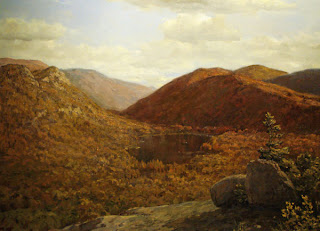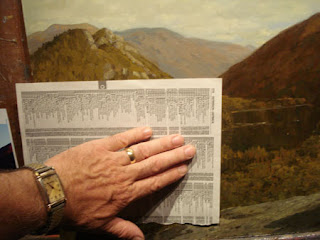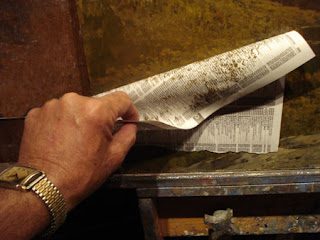
Richard Lack, image from the
Gandy galleryOn Tuesday Richard Lack died. Let me tell you a little about him and what he did. Richard Lack was from Minnesota and studied at the Minneapolis College of Art. He was interested in realist and old master painting and went to New York hoping to find instruction in that. He was unable to find what he was looking for until one day as he was copying a painting in the Met, he was approached by another young artist who told him about R.H.Ives Gammells small atelier in Boston. From 1950 until 1956 Lack (with a couple of years taken off to serve in Korea ) studied with Ives in the Fenway studios.
In 1957 Lack returned to Minnesota. I remember hearing how disappointed Gammell was that he did not stay in Boston. With (I believe) financial assistance from E.T.Greenshields and Ives Gammell Lack in 1969 opened the Atelier Lack. An atelier is a studio school based on the 19th century French methods of teaching. Both men hoped to foster a resurrection of traditional painting in America. They certainly got their moneys worth. Dozens of ateliers spread across the world have their roots in the Atelier Lack. He trained students who set up their own ateliers . There is now an international web of teaching ateliers mostly because of Richard Lack, setting up his own, in Minneapolis, of all places.
In the Atelier Lack, students were taught in the hybrid Boston school-French methods of mostly visual draftsmanship before the cast and with a focus on still life, portraits and figures. Lack took the Gammell teaching system and work ethic and made an organized "school" for painters out of it. He said " I can teach you to paint" in a time when the very idea of teaching someone to paint was in doubt. 1969 was in the time of total dominance by the Avant Garde school of thought that still runs the academic institutions, but does not have anything like the hold it once did on the larger art world. What he set out to do was intensely radical and he was treated like a pariah in the art world. But there were plenty of young students who wanted what he had. I was one.
I became aware of Richard Lack in the late sixties, I think it was just as, or just before he established his atelier. I lived eighty miles south of Minneapolis in Rochester, Minnesota. Rochester had a fine little Art Center with an exhibition space that did revolving shows. My mother took classes there studying art history in what must have been an excellent program that went on for many years. Oddly, I still remember the name of the woman who taught it, Polly Krinke. While at the Art Center my mother saw a show of the work of Richard Lack and insisted that I go see it too. I did and I guess I was impressed, but I was too young to realize what it was and I supposed that the Minneapolis College of Art (and later, design) would teach me what I needed to know. It is important to stress how totally naive, stupid and bereft of any good sense at all I was at this point.
I drifted through art school for a a year and the University art department for another, until I met a student of Richard Lack one evening in the etching labs and was very impressed with his work. I told that story
here. At his suggestion I visited the Atelier Lack and signed up for an course of evening drawing classes. The Atelier Lack was up a flight of stairs in a section of Minneapolis called uptown that was full of low rise office buildings and stores from the streetcar area. Uptown was a bustling place and the quiet deliberation that went on in the studio was a big change after walking through the busy city surrounding it. I remember all these years later the layout of the Atelier.There were little individual carrels set up for each of the students to study cast drawing and still life.
He had a figure model and we surrounded her on drawing horses, those sort of bench-drawing board- easels, and he came and gave each of us individual instruction. I wish I could remember more or what he told me but I do not. I know I was encouraged to copy drawings and did quite a few, mostly Ingres. I do remember a student asking him to dissect the composition of an old master (I think Italian) painting in a book. A semicircle of us stood around him and we listened to his description of the rhythmic lines that bound the design together.
I believe I was told by a student, or more likely a monitor who oversaw the evening classes sometimes, that there was no room left in the atelier, or perhaps they didn't take me very seriously and gave me that reply. Either way I began the correspondence with Ives Gammell that would lead me to Boston and my training there. I don't remember that I took more than that one series of evening drawing class and I certainly passed unnoticed through the scene there. I have so many times like Forrest Gump been a fly on the wall in some very interesting places .
Richard Lack was himself a fine painter and did many portraits, here is one of his daughter

Richard Lack painted landscapes, still life allegorical pictures and who knows what else. He was an excellent teacher partly because he could already do most anything you wanted to learn.
In 1983 Richard Lack while organizing a show of his work and that of some students and friends coined the phrase "Classical Realism" that phrase is heard so often now, it is easy to forget it didn't always exist. Lack coined it to define what he and like minded artists were doing, and to differentiate it into a separate category from just realism, which of course, would include photo realism and Andy Warhols soup cans, popular at the time.
Lack turned the Atelier over to several of his students in 1992 due to health problems, and it became simply "The Atelier". The class I took there was well over thirty years ago and I have no idea what goes on there now. I am glad that although I never really knew Richard Lack, I had a chance to meet him and study briefly in his studio. The little atelier that Richard Lack started had a big role in the revival of interest in traditional painting and that influence is growing geometrically now.Ives Gammell never lived to see the change, but Richard Lack did. I hope he was satisfied when he died that his had been a life well lived and of service to the art that was so important to him.
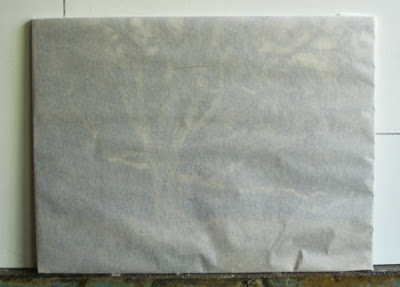 First, I taped tracing paper from a roll, over the panel from yesterday. I then pulled a tracing from the painting below, just the major lines are enough.
First, I taped tracing paper from a roll, over the panel from yesterday. I then pulled a tracing from the painting below, just the major lines are enough.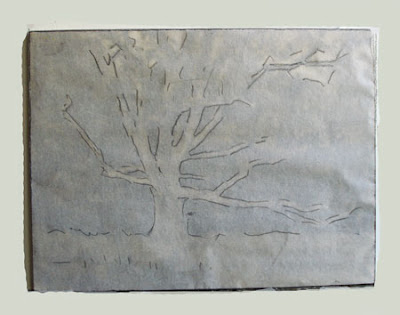 I run my soft pencil around the edge of the panel to mark that, and then I tape the tracing paper into the middle of a larger panel. I use artists transfer paper,that's important. Unlike carbon paper (does anyone still use that stuff, now that no one types? ) transfer paper has no wax in it. Painting over anything containing wax can be a problem, particularly in water media. Here is the transfer paper, it comes in a number of different colors, but I only stock two kinds, black for working on white grounds, and yellow for transferring to dark grounds.
I run my soft pencil around the edge of the panel to mark that, and then I tape the tracing paper into the middle of a larger panel. I use artists transfer paper,that's important. Unlike carbon paper (does anyone still use that stuff, now that no one types? ) transfer paper has no wax in it. Painting over anything containing wax can be a problem, particularly in water media. Here is the transfer paper, it comes in a number of different colors, but I only stock two kinds, black for working on white grounds, and yellow for transferring to dark grounds.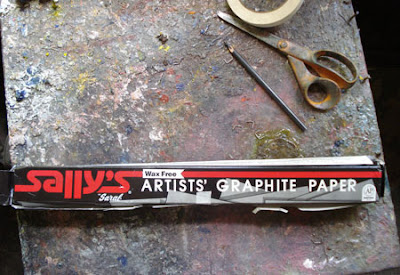 I slip a partial sheet of transfer paper between my tracing and the panel. I go over the lines again with my ebony pencil and then I have this.
I slip a partial sheet of transfer paper between my tracing and the panel. I go over the lines again with my ebony pencil and then I have this.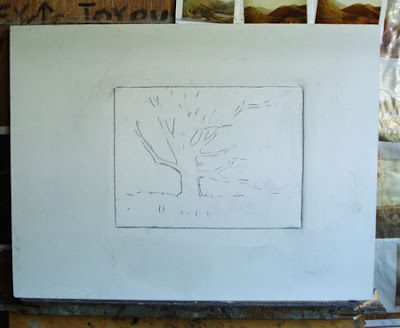 Then I drove up to Laconia, about an hour north and set up again in front of my tree. This time I have plenty of room around the tree to add whatever amount of the surroundings I want. There is a pond with deep black water and lilly pads and colored leaves floating in it, and there are cattails across the foreground, I know I want those. I also want more air around that tree so I will paint out from it a ways, and then crop to what I want to keep. I do need the cropped image to be 3 by 4 in proportion though.
Then I drove up to Laconia, about an hour north and set up again in front of my tree. This time I have plenty of room around the tree to add whatever amount of the surroundings I want. There is a pond with deep black water and lilly pads and colored leaves floating in it, and there are cattails across the foreground, I know I want those. I also want more air around that tree so I will paint out from it a ways, and then crop to what I want to keep. I do need the cropped image to be 3 by 4 in proportion though. This one below, is looking along an old Shaker wall with one of their communal fields on the left. I guess this tree is old enough to have been there in those days.I like to take pictures in the last hour of light, even on a gray day I get the look I want. Lately when I have been out painting, I make a point upon packing up, of getting out my camera and walking around to take some pictures.
This one below, is looking along an old Shaker wall with one of their communal fields on the left. I guess this tree is old enough to have been there in those days.I like to take pictures in the last hour of light, even on a gray day I get the look I want. Lately when I have been out painting, I make a point upon packing up, of getting out my camera and walking around to take some pictures. I was feeling so BLESSED to be in New England today. I don't often throw that word around, but I don't know any other way to describe how perfect the back roads of New Hampshire are in the autumn as the light fails.
I was feeling so BLESSED to be in New England today. I don't often throw that word around, but I don't know any other way to describe how perfect the back roads of New Hampshire are in the autumn as the light fails.





